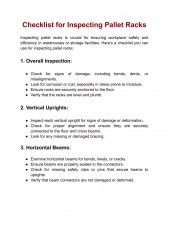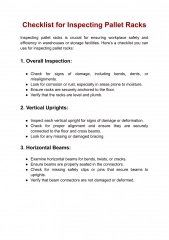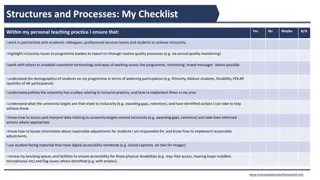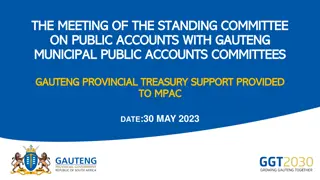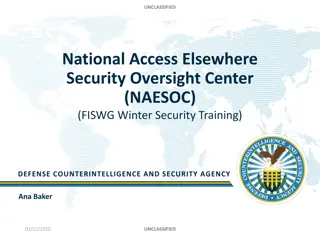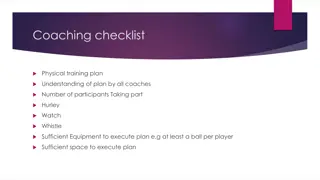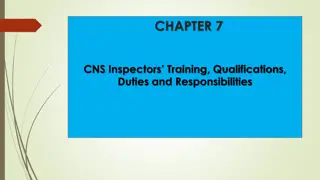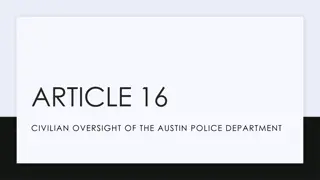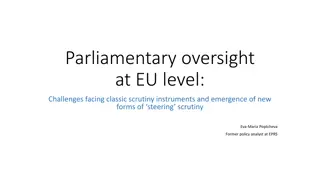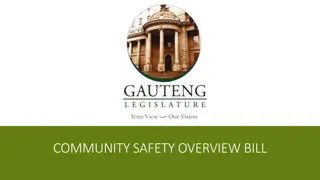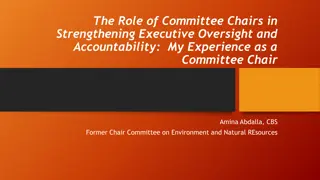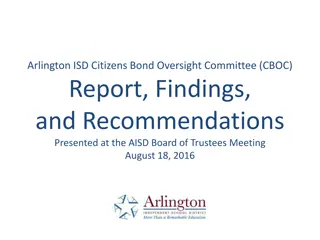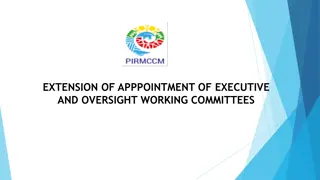Energy Opportunities Oversight Checklist for Effective Energy Management
A comprehensive checklist for overseeing energy management actions, including assessing responsibilities, prioritizing actions, and ensuring optimal tariff usage through investigation. The checklist aims to facilitate proactive energy management practices and enhance sustainability efforts in alignment with ecoBiz coaching principles.
Download Presentation

Please find below an Image/Link to download the presentation.
The content on the website is provided AS IS for your information and personal use only. It may not be sold, licensed, or shared on other websites without obtaining consent from the author.If you encounter any issues during the download, it is possible that the publisher has removed the file from their server.
You are allowed to download the files provided on this website for personal or commercial use, subject to the condition that they are used lawfully. All files are the property of their respective owners.
The content on the website is provided AS IS for your information and personal use only. It may not be sold, licensed, or shared on other websites without obtaining consent from the author.
E N D
Presentation Transcript
ENERGY OPPORTUNITIES CHECKLIST
Who is responsibility for oversight of action Energy Management Yes No N/A Action Priority e.g. Book a one-on-one with an Has an investigation being carried out to ensure the most ecoBiz coach (sustainability effective tariffs are used? expert) to review bills with Has electricity use in off peak periods been considered to take advantage of cheaper tariffs? Are process control devices used to optimise equipment use? Is there sub-metering on equipment that consume large amounts of energy that are monitored regularly? Is operating energy use considered/compared for new equipment purchases? Have other energy sources been considered e.g. solar panels or heating or alternate gas supplies? Is there potential for heat recovery from items of equipment? Has an energy audit been carried out?
Who is responsibility for oversight of action Lighting Yes No N/A Action Priority Are lights always switched off when not in use (i.e. in storerooms, conference rooms)? Where appropriate is energy efficient lighting used (e.g. incandescent bulbs replaced with compact fluorescents, T8 fluorescents replaced with T5s, 50W halogens replaced with LED etc...)? Is natural lighting used wherever possible during the day? Are there separate lighting controls for sections of large areas? (e.g. using half of a room) Are occupancy sensors and timers used in relatively inactive areas to automatically turn off lighting? Are there any opportunities to delamp in overlit areas (while being mindful of OH&S requirements)? Are dimmer controls used where appropriate? Are light fittings and reflectors, windows and sky lights cleaned regularly? Is there a system for turning off lights at the end of the day/shift (e.g. timers or photo sensors that measure natural lighting)? Is security lighting on a timer? Do facilities have a night time close-up checklist for all lighting?
Who is responsibility for oversight of action Refrigeration - (Part 1) Yes No N/A Action Priority Do all fridges need to be running all the time? Are fridges turned off over extended holiday or workshop shut-down periods? Can thermostats in cold rooms and freezers be set higher (while still meeting food safety standards)? Are freezers defrosted when frost build-up is greater than 5mm or are there demand controls that initiate defrosting by measuring the frost accumulation, humidity etc? Are seals in good order around doors of all fridges, freezers and cold rooms? Is 'good operator practice' encouraged so doors are only opened when necessary? e.g. signage Are condenser fins kept free of dust? Are fridges located in a well-ventilated area, with adequate air space surrounding them? When purchasing new refrigeration, are energy star ratings and energy consumption considered? Are fridges and compressor units sited away from heat sources and direct sunlight? Are lights switched off in refrigerators, units and cabinets overnight? Where possible, is energy efficient lighting installed e.g. LED lights
Refrigeration - (Part 2) For Commercial/Industrial Systems For discussion with service provider Who is responsibility for oversight of action Yes No N/A Action Priority Are the fans on the condensers and evaporators in good working order (not noisy)? For larger systems consider installing energy efficient fan motors. Is the compressor energy efficient? (consume between 80- 100% cent of the system s total energy use) Is waste heat recovered from the compressor? Are refrigerant levels monitored (leaks can cause significant environmental and OH&S problems and causes the compressor to work harder)? Do reach in refrigerators have insulated glass doors and are night covers (aluminum shields) used? Is hot refrigerant vapour discharge from the compressor used to defrost evaporators? Is space effectively utilised and unused space closed off? (Consider benefits of racks) Are suction lines to the compressor insulated? Has absorption refrigeration been considered where there is a waste heat source readily available or electrical load limitations?
Who is responsibility for oversight of action Electric Motors Yes No N/A Action Priority Are all motors matched to load size? Your electrician can advise Has replacing old motors with newer, high-efficiency or variable speed motors been investigated? Are checks carried out periodically to examine belt tension? Can energy be saved by avoiding motors being run at part load for long periods of time? Are motors always switched off when not in use? Is the output of motors matched with demand e.g. installation of variable speed drives, multi speed motors or several smaller motors with control system? Have power factor options have been discussed with power supplier or consultant e.g. correction capacitors, correction equipment, high power factor lighting and electronic equipment? Are motors well maintained e.g. clean, aligned, connections and wiring not loose and bearings in good condition.
Who is responsibility for oversight of action Heating, air conditioning and ventilation Yes No N/A Action Priority Are windows (especially east and west facing) located to avoid heat entry in summer or curtains and blinds, external shades or vegetation, reflective pane or solar screen or transparent low- emissivity (low-e) coatings, multiple window panes etc used to minimise heat entry? Is there insulation in the ceiling/walls/floors? e.g. write routine checks into position descriptions and work flows Is there a system for regular checks, record keeping and repair of leaks? Are ducts insulated, especially those in un-air conditioned spaces such as in the ceiling? Are fans, air-conditioners or heaters turned off when rooms or sections are not occupied? Do ducted systems allow segregation of different sections? Are timers used to ensure heating and cooling systems are turned off overnight and over weekends? When heating or cooling systems are being used, are doors or windows closed? Are doors and windows of air-conditioned areas sealed to prevent leakage? oC in summer and 19 oC Are thermostats for air-conditioners set at 25 in winter? Are the blades of fans cleaned regularly? Are outside units located in the shade of the building or protected from direct sunlight? Are air conditioners serviced and cleaned regularly? (condensor coils cleaned, refrigerant levels, air flow over the evaporator coils measured, ducts and seal checked for leaks, oil and belts of motor checked, accuracy of the thermostats etc). Is your system sized correctly for the cooling or heating load required? Do the energy controls on the air conditioning system or unit allow it to be operated efficiently?
Who is responsibility for oversight of action Pumps and Fans Yes No N/A Action Priority Are pumps and fans shut down when not in use? Are the size of pumps and fans well matched to the duty to they performed? Are variable speed drives installed on motors used to run pumps and fans? Have impellers on oversized pumps been trimmed? Are fans operated at the lowest speed required to do the job? Are sensors used to turn fans off when not required? Are the fan housing, impellor and ductwork clean and free of dust? Is ductwork regularly checked for leaks? Is ductwork correctly sized and does it allow unobstructed flow?
Who is responsibility for oversight of action Compressed Air Systems Yes No N/A Action Priority Is the compressor turned off after hours, either by staff or time control switches? Is the compressed air system checked regularly for leaks and repaired if necessary? Is the compressed air distribution system a ring main or grid distribution? Is the operating pressure optimized? Can an alternate supply be provided for equipment items requiring a much higher air pressure than other equipment rather than operating the whole system at the highest pressure? Is the coolest air possible used for intake air? Are filters cleaned regularly? Is the length of piping kept as short as possible and the joins smooth? Is the system suited to the load i.e. correct type, not oversized? Has a combination of compressors or a sequence controller on multiple compressors been installed to help respond more efficiently to load requirements? Is heat recovered from the compressor been considered?
Who is responsibility for oversight of action Boilers and Water Heading (part 1) Yes No N/A Action Priority Does the hot water tariff match water demand and storage capacity? For general hot water use, are thermostats set at optimum temperature of 60 oC? Are there any taps and pipes leaking steam or hot water? Are instantaneous urns switched off at night, either by staff, cleaners or time clocks? For storage water heaters, does the size of the tank match hot water demand? Have hot water systems or boilers have been converted to a more efficient fuel? e.g. electricity to gas Have alternative fuel sources such as solar, ground or air heat (heat pumps) or biomass been considered? Is cold water used instead of hot water whenever possible? Are pipes and tanks insulated to prevent heat loss? Is the entire hot water system checked regularly for leaks? Are staff encouraged to use hot water efficiently? Have flow rates been optimised for fixtures or equipment using hot water?
Boilers and Water Heading (part 2) Commercial/Industrial Boilers For discussion With service Provider Who is responsibility for oversight of action Yes No N/A Action Priority Are conductivity probes installed to initiate blowdown only when necessary? Is blowdown water reused in the plant? Does a blowdown heat recovery system preheat boiler feed water? Is the flue gas temperature regularly recorded and compared to optimal temperature? Are boilers regularly cleaned to remove scale and soot that reduce heat exchange efficiency? Is feed water analysed and effectively treated to minimise scale build up? Are flue gases regularly analysed? Is a flue meter or portable flue analysers used and compared to optimal gas percentages? Is an oxygen trim system used to keep gas percentages optimal? Has a heat exchanger (economiser) been installed on the flue to preheat boiler feed water? Is flue heat used to preheat combustion inlet air? Is pipe work optimised (e.g. removed if redundant, not over or undersized, correctly sloped)? Are steam lines and traps are regularly checked for steam leaks that are repaired promptly? Are the boiler surface, steam and condensate lines insulated and in good condition? Is as much condensate as possible returned to the boiler feed tank? Have oversized boilers that are continually cycling been downsized? Are boilers operated at their maximum design pressure and reducing valves installed if necessary? Are boilers started up as late as possible and shut down as early as possible? Are hot water systems or smaller boilers used to meet hot water demand outside production hours? Is the exhaust heat from one part of the process used to heat another (heat cascading)? Where possible are heat and power systems combined to produce both electrical and thermal energy (e.g. cogeneration).
Who is responsibility for oversight of action Office Equipment Yes No N/A Action Priority Is office equipment turned off at nights and on the weekend (reminder notices in strategic locations to remind staff)? Is there a night time knock-off checklist for all office equipment? Where facilities are cleaned nightly, do cleaning staff switch off equipment left on after hours? Is automatic energy-saving sleep mode on printers and copiers utilised? Are computers and monitors turned off or configured to power down when they are not being used for extended period? Have the settings on monitors been set to replace screen savers with sleep setting? Have the settings on computers been set to go to sleep after a period of inactivity? Is existing office equipment energy efficient? When new office equipment is being purchased, is energy efficiency taken into consideration? Does the office have too many photocopiers and printers? If photocopiers are switched on all day, can copying be practically limited to certain times? Are battery chargers (e.g. for phones, iPods, tablets) left on continuously?
Who is responsibility for oversight of action Cooking Yes No N/A Action Priority Are microwave ovens, electric frypans and kettles used for cooking rather than stovetops? Are deep fryers, hotplates and bain-maries turned down during quiet periods? Is there a start-up and shutdown plan to make sure equipment is only operating when needed? Is cooking equipment maintained (e.g. damaged door seals, clogged burners)? Is there a program to check the calibration of thermostats? Are cooking surfaces kept clean to maintain better heat transfer? Do exhaust fans have variable speed drives on their motors? Is good quality and appropriate cookware used? Are controls installed on equipment where cooking times and temperatures can be standardised (i.e. automated using timers and thermostats)? Are energy efficiency cooking practices followed e.g. limiting opening the door of heating appliances, preheating equipment for the time and setting recommended by the manufacturer, cooking in large batches etc Are cooking equipment and appliances energy efficient? e.g. convection ovens, microwaves, high-end electric fryers, induction or tungsten halogen cook tops, griddle options when replacing old char grills? Are appliances oversized or under utilised? E.g. washing machines Is cooking equipment insulated(e.g. holding cabinets)?
Who is responsibility for oversight of action Building and Renovating Yes No N/A Action Priority Has generation of renewable energy been considered (solar photovoltaic, wind, biogas etc)? When carrying out new building or renovations, are energy-efficient design principles employed? Are ceilings, walls or floors insulated? Are east- and west-facing windows and walls well shaded (awns, eves, vegetation) in summer? Are internal shade fixtures such as blinds or curtains effective and used? If not, have other alternatives been considered such as glass and window film treatments, double-glazing etc Do the materials used to construct the building significantly help with its energy performance e.g. ability to insulate? Are windows and doors positioned to maximise natural ventilation (especially in workshops)? Is the air conditioning system an energy-efficient model (reverse- cycle inverter system that can be used for winter heating)? Is a central gas heating system or reverse cycle air conditioner used instead of a standard electric heater? Is the hot water system efficient e.g. a solar, electric heat pump hot or gas Are deviced such as flow restrictors or water efficient fixtures installed to save hot water? Is the building designed to maximise natural lighting? Do lighting fixtures provide sufficient lumination while also being energy efficient? Are appliances energy efficient? Is the building location close to public transport and are staff encouraged to use it?
Who is responsibility for oversight of action Transport Yes No N/A Action Priority Has an investigation been carried out into the economics of converting vehicles to LPG or purchase of hybrid or electric vehicles? Has the use of blended fuels been considered e.g. biodiesels or biofuels e.g. ethanol petrol? Is the number of required trips minimised by using full loads or using couriers for deliveries? Is regular maintenance carried out on vehicles to reduce fuel consumption? Is fuel consumption considered for the purchase of new vehicles? Are transport emissions offset e.g. GreenFleet? Do drivers follow good driving practices to reduce fuel consumption? Are staff encouraged to walk, ride a bike or take public transport to and from work? Is there a car pooling program? Do staff telecommute or teleconference where possible? Could staff work from home at times to reduce the need to commute? Are materials purchased locally where possible?


